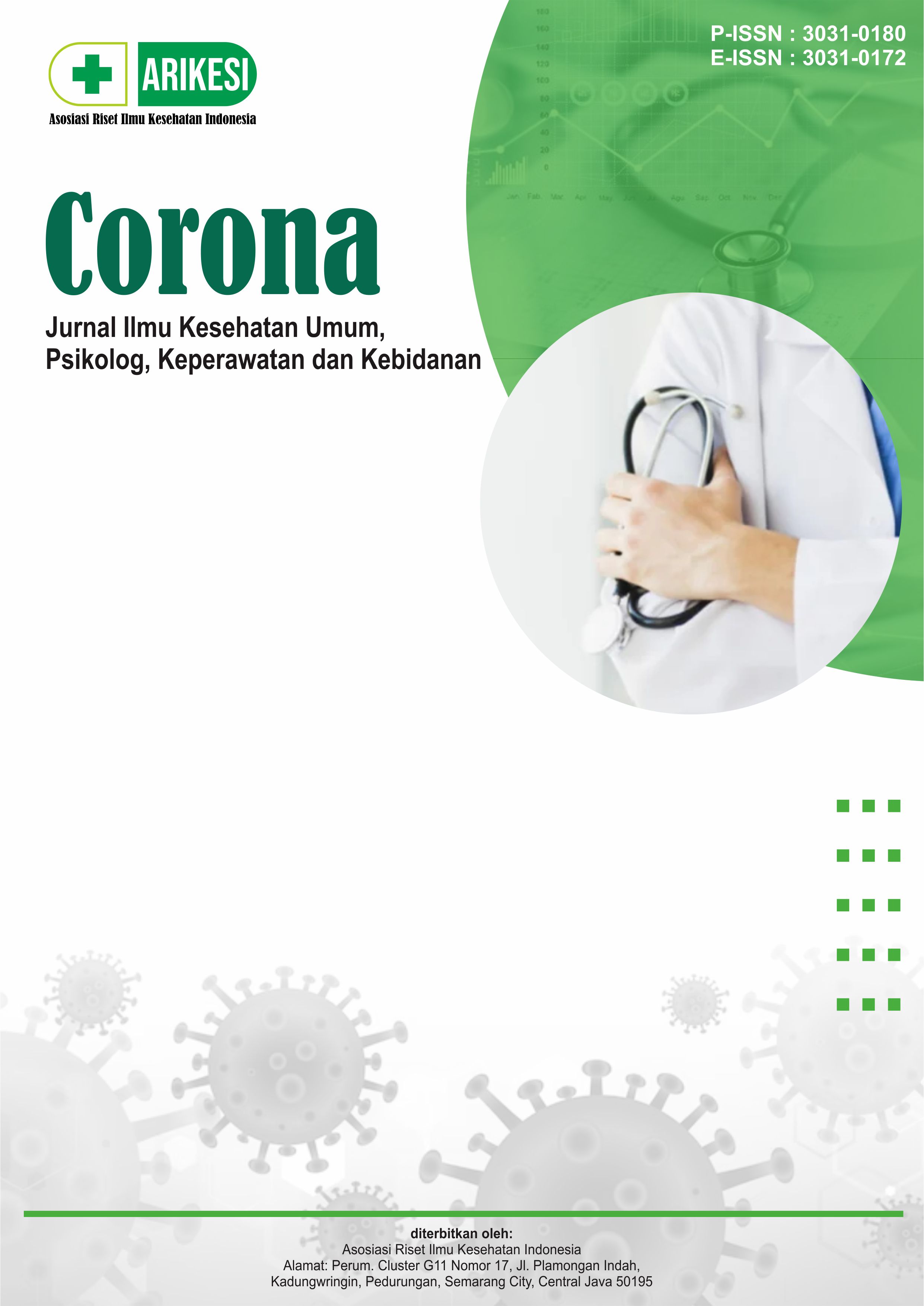Gambaran Karakteristik Pasien Dispepsia di Rumah Sakit
DOI:
https://doi.org/10.61132/corona.v2i3.536Keywords:
Drug use, Dyspepsia, Medical historyAbstract
Dyspepsia is a disease of the digestive tract that is not contagious but is common among people in the world. Dyspepsia can be experienced by various age ranges, gender. According to research, the risk factor for organic dyspepsia is age > 50 years. This is thought to be related to the increasing prevalence of chronic diseases in old age. Dyspepsia has an impact on quality of life because the natural course of dyspepsia is chronic and often recurs. This research is a quantitative research using a descriptive analytic research design. The sample in this study were dyspepsia patients at Nurdin Hamzah General Hospital, East Tanjung Jabung Regency, totaling 80 people. The sampling technique used in this research is purposive sampling technique. This research was conducted at the Nurdin Hamzah General Hospital, East Tanjung Jabung Regency, in 26 June – 04 July 2023, then the data will be obtained by looking at the medical records of dyspepsia patients at the Nurdin Hamzah General Hospital, East Tanjung Jabung Regency. Data analysis was performed univariately. Based on the results of the study, it was found that patients aged > 65 years (elderly) were 20 respondents (25%) with dyspepsia, some of the dyspepsia patients were female, namely 55 respondents (68.8%), with working status, namely 44 respondents (55.0%) ), patients had a history of co-morbidities, namely 47 respondents (58.8%) and most dyspepsia patients had a history of drug use, namely 43 respondents (53.8%). It is recommended as input to the hospital to find out the problem about the description of the characteristics of dyspepsia patients
Downloads
References
Adiputra, I. M. S., et al. (2021). Metodologi Penelitian Kesehatan. Denpasar: Yayasan Kita Menulis.
Alwhaibi, A., et al. (2020). Prevalence and severity of dyspepsia in Saudi Arabia: A survey-based study. Saudi Pharmaceutical Journal, 28(9), 1062–1067. https://doi.org/10.1016/j.jsps.2020.07.006
Ayele, B., & Molla, E. (2017). Dyspepsia and associated risk factors at Yirga Cheffe Primary Hospital, Southern Ethiopia. Clinical Microbiology: Open Access, 6. https://doi.org/10.4172/2327-5073.1000282
Bouchoucha, M., Uzzan, B., & Cohen, R. (2011). Metformin and digestive disorders. Diabetes Metabolism, 37(2), 90–96. https://doi.org/10.1016/j.diabet.2010.11.002
Depkes. (2008). Permenkes RI No. 269/MenKes/Per/III/2008, Tentang Rekam Medis. Jakarta: Depkes RI.
Gayle, A. F. (2014). Kejadian dispepsia pada penderita diabetes melitus tipe 2 yang berkunjung ke poliklinik endokrin RSUD. Dr. Pirngadi Medan pada bulan September hingga November.
Guyton, A. C., & Hall, J. E. (2015). Buku Ajar Fisiologi Kedokteran (11th ed., Irawati RDIF, Ed.). Jakarta: Buku Kedokteran EGC.
Hantoro, I. F., & Syam, A. F. (2018). Measurement of health-related quality of life in patients with functional dyspepsia. Acta Medica Indonesiana.
Harer, K. N., & Hasler, W. L. (2020). Functional dyspepsia: A review of the symptoms, evaluation, and treatment options. Gastroenterology and Hepatology, 16(2), 66–74. Retrieved from https://www.gastroenterologyandhepatology.net/archives/february-2020/functional-dyspepsia-a-review-of-the-symptoms-evaluation-and-treatment-options/
Hasanuddin, M. B. (2020). Karakteristik penderita dispepsia di beberapa lokasi di wilayah Indonesia periode tahun 2012-2019. Makassar: Fakultas Kedokteran Universitas Bosowa Makassar.
Hasler, W. L., Coleski, R., Chey, W. D., Koch, K. L., Mccallum, R. W., Wo, J. M., Kuo, B., Sitrin, M. D., Katz, L. A., Hwang, J., Semler, J. R., & Parkman, H. P. (2008). Differences in intragastric pH in diabetic vs. idiopathic gastroparesis: relation to degree of gastric retention. American Journal of Physiology-Gastrointestinal and Liver Physiology, 1384–1391. https://doi.org/10.1152/ajpgi.00023.2008
Hastono, S. P. (2016). Analisis Data pada Bidang Kesehatan. Jakarta: PT Raja Grafindo Persada.
Hutubessy, J. (2018). Hubungan kebiasaan pemakaian obat anti-inflamasi nonsteroid dengan kejadian sindrom dispepsia di Puskesmas Bambanglipuro Bantul. Yogyakarta: Fakultas Kedokteran Universitas Kristen Duta Wacana.
Kenea, D. G., et al. (2020). The magnitude and associated factors of Helicobacter pylori infection among adult dyspeptic patients attending Bokoji Hospital, Southeast Ethiopia. Research Square. https://doi.org/10.21203/rs.3.rs-25765/v1
Laili, N. (2016). Faktor-faktor yang mempengaruhi dispepsia pada pasien dengan keluhan nyeri abdomen di RS Amelia Pare Kabupaten Kediri.
Mardalena, I. (2018). Asuhan Keperawatan Pasien dengan Gangguan Pencernaan. Yogyakarta: Pustaka Baru Press.
Nugroho, R. (2018). Gambaran karakteristik pasien dengan sindrom dispepsia di Puskesmas Rumbai. JOM FKp, 5(2).
Nurjannah. (2018). Hubungan antara umur dan jenis kelamin dengan kejadian gastritis kronik di Klinik Lacasino Makassar. Jurnal Ilmah Kesehatan Diagnosis, 12(1), 119-122.
Putri, A. N., Maria, I., & Mulyadi, D. (2022). Hubungan karakteristik, individu, pola makan dan stres dengan kejadian dispepsia pada mahasiswa Program Studi Kedokteran Universitas Jambi angkatan 2018. JOMS, 2(1), 2022.
Riset Kesehatan Dasar (Riskesdas). (2018). Retrieved from http://www.depkes.go.id/resources/Jdownload/infoterkini/materi_rakorpop_2018/Hasil%20Riskesdas%202018.pdf
Sabran, D. A. (2021). Buku Ajar Praktik Klinis Rekam Medis (Pengantar Awal Turun Lapang). Cetakan Pertama: CV Pelita Medika.
Sari, D. R. (2016). Karakteristik penderita dispepsia di RSUP Dr. M. Djamil Padang tahun 2013 - 2015 [Skripsi]. Retrieved from http://scholar.unand.ac.id/17680/
Soraya, A. A. H., & Wahyu, A. (2021). Konsep Dasar Rekam Medis dan Informasi Kesehatan (RMIK). CV Lisertasi Nusantara Abadi. ISBN: 978-623-329-418-8
Sucipto, C. D. (2020). Metodologi Penelitian Kesehatan. Yogyakarta: Gosyen Publishing.
Sugiyono. (2017). Metode Penelitian Kuantitatif, Kualitatif, dan R&D. Bandung: Alfabeta, CV.
Suri, I., Marvel, & NurJulilis. (2020). Gambaran karakteristik pasien dan penggunaan obat dispepsia di Klinik A daerah Bekasi Timur. Pharmaceutical And Biomedical Sciences Journal.
Swarjana, I. K. (2015). Metodologi Penelitian Kesehatan (Edisi Revisi). Yogyakarta: ANDI.
Tamimi, L. H., Herardi, R., & Wahyuningsih, S. (2020). Hubungan antara tingkat stres akademik dengan kejadian dispepsia pada siswa kelas XII IPA di SMA Negeri 81 Kota Jakarta Timur tahun 2019. Jurnal Penyakit Dalam Indonesia, 7(3), 143. Retrieved from http://jurnalpenyakitdalam.ui.ac.id/index.php/jpdi/article/download/399/241
Tiana, A., et al. (2017). Hubungan antara sindroma dispepsia dengan pola makan dan jenis kelamin pada mahasiswa Fakultas Kedokteran Universitas Kristen Krida Wacana angkatan 2013. Meditek. Retrieved from http://ejournal.ukrida.ac.id/ojs/index.php/Meditek/article/view/1562
Walker, M. M., & Talley, N. J. (2019). Functional dyspepsia in the elderly. Current Gastroenterology Reports, 21(10). https://doi.org/10.1007/s11894-019-0722-5
Zakiyah, W., et al. (2021). Definisi, penyebab, klasifikasi dan terapi sindrom dispepsia. Journal Health Sains, 2(7), Juli 2021.
Downloads
Published
How to Cite
Issue
Section
License
Copyright (c) 2024 Corona: Jurnal Ilmu Kesehatan Umum, Psikolog, Keperawatan dan Kebidanan

This work is licensed under a Creative Commons Attribution-ShareAlike 4.0 International License.





